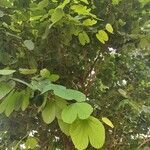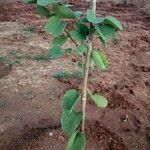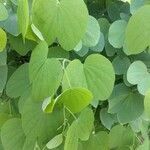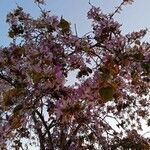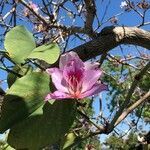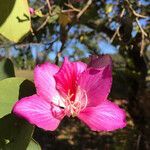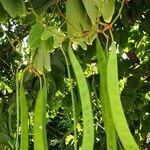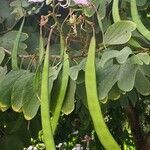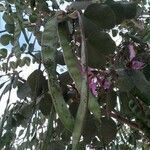Trees, deciduous, to 15 m tall. Bark dark brownish, nearly smooth; branches gray puberulent when young, later glabrous. Petiole 2.5-3.5 cm; leaf blade suborbicular or broadly ovate, 5-9 × 7-11 cm, subleathery, abaxially almost glabrous, adaxially glabrous, primary veins 9-13, secondary and higher order veins protruding, base shallowly to deeply cordate, apex bifid to 1/3, lobes rounded at apex. Inflorescence a raceme, few flowered, sometimes corymblike, axillary or terminal. Flower buds fusiform, smooth, subsessile. Calyx open as a spathe into 2 lobes. Petals white, or with pink or purplish spots, obovate or oblanceolate, 4-5 cm, clawed. Fertile stamens 5; filaments ca. as long as petals, slender. Staminodes 1-5 and small, or ?absent. Ovary stalked, puberulent; style curved; stigma small. Legume linear, flat, 15-25 × 1.5-2 cm; valves woody. Seeds 10-15, compressed, suborbicular, ca. 10 mm in diam. Fl. Feb-May, fr. Mar-Jul. 2n = 28.
A tree. It loses its leaves during the dry season of the year. It grows to a height of 8-12 m tall and spreads to 5 m across. The stem is erect and straight. The leaves are entire to the midpoint, then divided into 2 lobes. The leaves are 10-20 cm long and 10-15 cm across. The base of the leaves is heart shaped. They are dull blue-green. The veins radiate from the base of the leaf. The leaf stalk is 2-3 cm long. The flowers are pink to purple with 5 club-shaped petals. One petal is a different shape and colour. They are produced on stalks around a flowering stalk at the end of branches. The flowers are 8-12 cm across. The fruit are pods. They are 20-30 cm long and 1.5-2.5 cm wide. They are flat and brown and twist as they open. There are 10-15 seeds. The seeds are round and flat and 1 cm across.
